Stop Tweeting right now! Stop link building right now! On you existing site, there is at least 100% revenue growth hidden in very simple changes.
Most effort of bloggers and ecommerce websites goes into the traffic generation efforts but when you already have thousands of visitors per day to your website, it’s time to start looking at improving your conversion rate before generating any more traffic. Put simply, the conversion rate is the total amount of visitors divided by the ones that take some sort of desired action on your site. It could be the visitors that download your ebook, purchase your product or sign-up for you newsletter or workshop — however you choose to define it.
Conversion rates vary a lot but it is usually between 1% and 10%, meaning that of every 1000 site visitors, 10-100 perform your desired action. Every single percentage point you can improve can have a major effect on your bottom line, without spending any more money to buy traffic, so NOW is a good time to take a look at what you can do to improve your conversion rate.
One of the best things you can do is to de-clutter your website of all elements that stand in the way of the visitor preforming the desired action.
Example with lots of profit gain
A good example of de-cluttering a website is to look at the example below of Audio Edition that saw 67.4% improvement on the sign-up page by making the most important page simpler. In this test, Blast Advanced Media removed all of the left and right side elements that were referring to discount plans, newsletters, contact methods bookmarking and the ever-popular top 10 searches.
Imagine what you can do with your website by removing elements that do not contribute to your main revenue stream. Lets look further on how to get your double-digit improvements.
What Do You Want Me to Buy?
The most common question I get from clients at Reedge.com that are considering testing is “What do I start testing?” The most important thing to do is to step back and look at your page and see if you can find the product or service that is making money for your site. This will be different for each site, but here are the most common ones:
- Blog: both news and ads (money comes from pageviews)
- Ecommerce: products
- Lead generation: leadform
- Digital content: the ebook or product
After several years of growing a business, most online entrepreneurs get thrown from left to right by the perceived need to update their blogs, be social, build email databases … the list of suggestions goes on, but the truth is that all of these things can distract you from doing your core job of converting your website visitors into paying customers.
Every item on the page is shouting for attention and its all equally important on most pages. Why do you need a Twitter button on your ecommerce site on every product page? Dell has generated millions of dollars on their website and it’s impossible to find a Twitter button on any product page. That is because Dell realizes that your will happily Tweet about your new computer after you bought it. Why pay for Google AdWords when all you get is a Facebook ‘Like’ in return when that should have been a lead instead?
We also see lots of products mixed on one page. Newsletter sign-ups mixed with free whitepaper on a ecommerce site is nothing but a distraction from the buying process. Introduce alternative products at a stage where they are more fitting. For example, promote the newsletter during or after checkout or on the second or third visit to your website. A whitepaper, for instance, can be a good tool to identify a buying stage in B2B environments but less functional in B2C.
What Do You Change First?
You start making changes on pages with the most traffic and the changes should be directly noticeable. These changes will bring significant differences in conversion and make you learn fast what works for your audience.
In this image, I place the most important elements for an ecommerce website that will increase conversion.

Testing Tools
To be able to grow, you need to measure the results, but an analytics tool cannot tell you what changed elements on your page have contributed to your revenue. You need a testing tool to determine if you changes have an impact and where they impact your business.
Google Website Optimizer is a free tool from Google that allows you to start with testing. You have to make multiple variations of the same page or ask you designer to assist. You add a different code on each variation page and a different javascript code on the thank-you page after the product was sold or lead was sent, also called the conversion page. Google Website Optimizer shows you the exact effect that each different page (variation) had on the conversion rate.
Reedge.com (my start-up) is a paid tool that allows you to select the elements of the page you want to change without the help of a designer. You need one javascript code for the entire site that never changes. Setting up new tests take around 3 minutes and the effect can be significant.
Both products give the same outcome in test results and you would need around 25 conversions on each variation to get a statistically significant outcome of the test. In other words, if you are testing four variations, each variation needs around 25 conversions for the tool to tell you which version has the most impact on your conversion rate.
Dennis van der Heijden is CEO of Convert.com , a Conversion Optimization.











I agree with your point. I was working a project that generated lot of traffic on the site but the goal conversion was very low. I will look in to that for more details
Most of the companies just want to see big numbers in the traffic/fans/followers/etc… but clearly the most important thing at the end are sales/conversion!